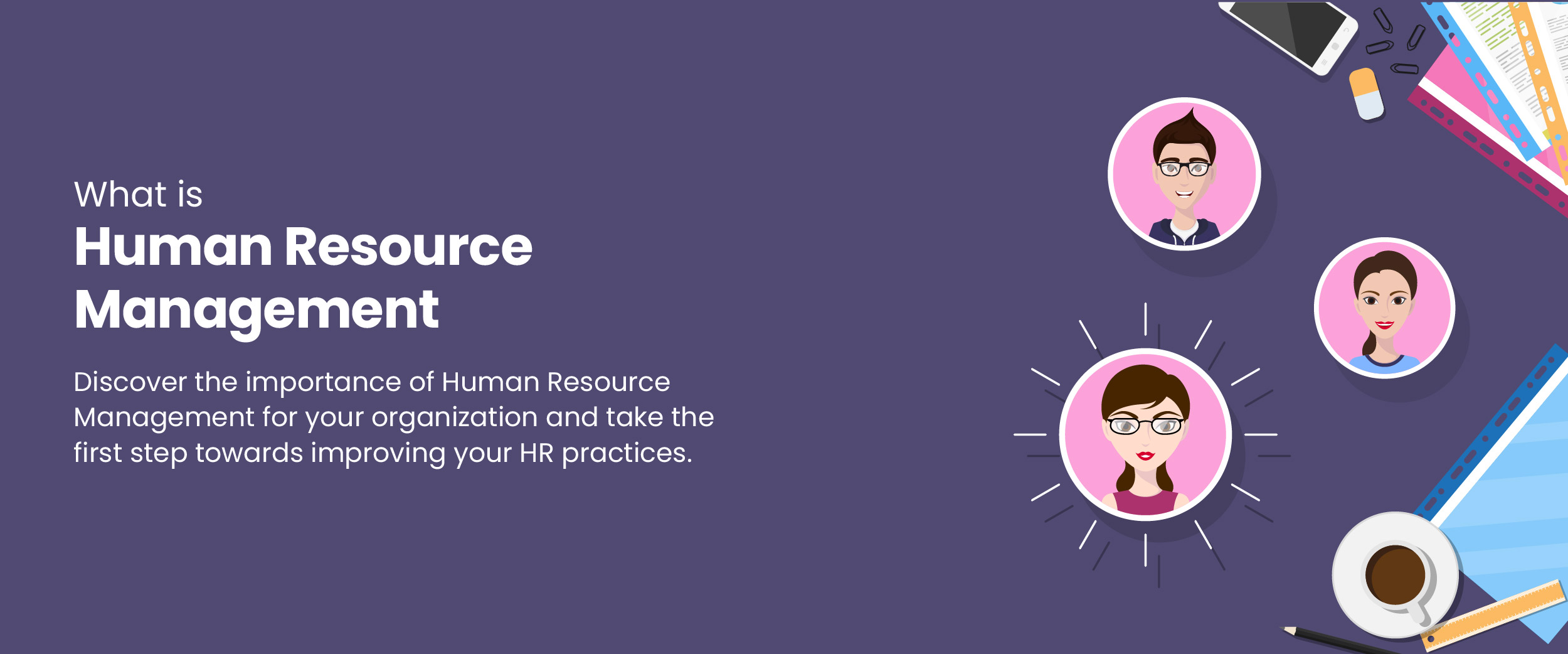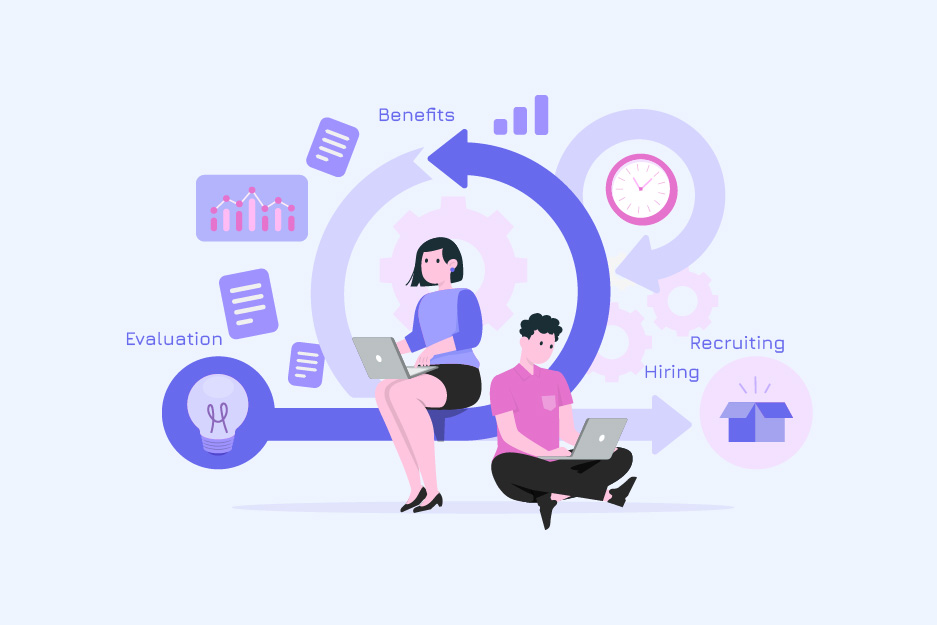What is Human Resource Management?: Importance, Skills, Objectives, & More
According to a recent study, the HR industry is expected to grow by 12.8% in 2024 with several job openings for both fresher and experienced professionals. If you are interested in exploring this domain, you should familiarize yourself with the concept of human resource management. It is a process undertaken by the human resources department and involves the management of the human capital of an organization. In this blog, we will learn what is human resource management, its importance, characteristics, objectives, functions, scope, and more.
Introduction to Human Resource Management
It is the practice of managing human capital or the employees of an organization to achieve organizational goals and objectives. It involves responsibilities like recruiting, training, retaining, compensating or paying, promoting, and motivating employees.
Organizations, regardless of their size of operations, depend on human resource management for the efficient running of their business. An HR manager is at the core of the activities of human resource management. They are responsible for strategically managing a company’s human capital.
To pursue the role of a human resource manager, you can explore various HR courses and begin your job preparation.
Evolution of Human Resource Management
The following are the various stages of the evolution of human resource management:
- Pre-Industrial Era: The workers were treated as a commodity and no proper human resource management practices were in place.
- The Advent of the Industrial Revolution: The 18th century saw a rise in factories and new technologies due to the Industrial Revolution. The focus also shifted towards maximizing productivity and efficiency with an increase in demand for skilled labor. This was possible only with proper management, leading to the idea of modern human resource management.
- Late 19th and Early 20th Centuries: Importance was laid on workers’ rights, safety concerns, and work conditions in factories.
- Emergence of Personnel Management: In the 20th century, organizations recognized the need for a structured approach towards workforce management, and HR departments in organizations emerged. Now, the focus is on legal compliance, workers’ satisfaction, and safety programs. During this time, the concept of employee welfare was introduced, which included sick leaves and insurance benefits.
- World War II Era: From the 1930s to the 1950s, the focus shifted towards human relations, and a more people-centric approach was adopted that emphasized communication and employee engagement.
- The 1970s: The personnel department became the human resources department.
- The 1980s: This is the era of the emergence of systematic human resource management, where the focus was on creating high-performing workplaces by implementing HRM practices, using performance management systems, developing metrics to evaluate the impact of HRM practices on business outcomes, etc.
- Contemporary Human Resource Management: It emphasizes diversity, equity, and inclusion. Technological advancement has led to the automation of HR processes, but the core of HRM remains the employees’ well-being.


Importance of Human Resource Management (HRM)
It is the job of HR to look after the needs of the employees and carry out any changes that need to be made to make the employees feel more comfortable and safe. Some of the importance the company could reap out of the HR manager and their team are:
- Strategy Management– HRM helps an organization in devising and implementing strategies to manage various aspects of employee lifecycle and relations. This includes recruitment, training, labor relations, etc.
- Benefits Analysis– It helps the organization analyze its current benefits package and modify it according to the latest trends and standards. Optimized benefits can help increase the employee retention rate and also attract top talent.
- Training and Development– HRM undertakes training and development of new employees to ensure their work aligns with the values and vision of the organization. It facilitates the uninterrupted and efficient functioning of business operations.
- Conflict Management– Human resources management plays a crucial role in conflict management at the workplace as it mediates between the employees and the organization to resolve issues.
- Establishing a Healthy Work Culture– HRM practices facilitate the creation of a healthy work culture where human capital is used to its full potential and better employee relations are maintained.
- Interactivity with Employees– HRM also helps in improving employee engagement and motivates them to put in their best efforts. This increases productivity and ensures fulfillment of short-term and long-term organizational goals.
Do you wish to pursue the dynamic field of human resources? Check out this HR course with placement guarantee and get ready to kickstart your professional journey!
Characteristics of Human Resource Management
Human resource management is essential for an organization to function effectively. Certain characteristics that make this practice unique are:
- People-Oriented: The HRM acknowledges the role of human capital in contributing to organizational development. It is people-oriented or employee-oriented because it involves recruiting, training, and developing skills to achieve business success.
- Decision-Oriented: HRM facilitates informed decision-making by analyzing potential outcomes and providing data-based insights about talent requirements and current inventory in an organization.
- Future-Oriented: HRM considers an organization’s future growth and possible employee requirements if there are organizational changes. This helps smoothen the business operations in case of unexpected scenarios.
- Universality: Though management practices may vary for different organizations, the core features of human resource management remain the same. They are also implemented at all levels of an organization rather than a particular one.
- Provides Opportunities: HRM provides opportunities for the overall growth of teams in an organization. These teams learn to set realistic goals or targets and achieve them in a time-bound manner. This helps optimize current strategies and reevaluate skills.
- Continuous Process: HRM is a continuous process rather than a one-time event. It focuses on managing the human capital from the beginning of an organization’s operations to its culmination.
Objectives of HRM
The following are the objectives of human resource management:
- Hire and retain the right talent for the organization.
- Ensure there are proper training and development programs for employees.
- Allocate HR resources efficiently to leverage their full potential.
- Communicate company rules and regulations, policies, and processes to employees.
- Work towards positive employee experience and promote well-being.
- Ensure legal compliance according to industry standards.
- Maintain a healthy workplace environment.
HRM Functions in an Organization
The most important capital of a business is its human capital as it makes up its backbone. If there will be no employees in a company, the company will cease to work which makes HR crucial to a company. Listed below are the various roles of a human resources manager:
Job Design and Analysis
The function of job design and analysis involves describing the role and responsibilities of a job and qualifications like education, skills, and work experience. It helps in identifying the right candidate to hire.
Hiring and Selection
The HR professionals screen resumes, schedule interviews, and select suitable candidates who can contribute positively to the organization.
Training and Development
This essential function ensures employees get growth opportunities through training and development.
Compensation and Benefits
Creating attractive compensation and benefits packages is an essential function of HRM. It helps in attracting and retaining top talent, motivates employees, and boosts productivity.
Performance Management
This function focuses on the performance of the employees, team, department, and even the organization as a whole. Regular feedback is provided to identify areas of improvement and increase the efficiency of the employees.
Employee Relations
Employee relations in an organization comprise both managerial and labor relations. The former is about designing appropriate work schedules for employees to maintain productivity. The latter manages relationships between the employees to create a harmonious workplace.
Health and Safety Regulations
HRM ensures that the mandatory health and safety protocols and regulations are followed. Employees are given relevant training and knowledge to create a secure working environment.
Personal Support to Employees
HRM assists employees with their personal problems. For example, an employee may need legal assistance or insurance assistance. Providing this assistance ensures that the employee’s workflow is not hindered.
Industrial Relations
Focusing on industrial relations practices helps the HR in meeting wage standards, improving working conditions of employees, reducing instances of strikes, etc. This function is crucial in mitigating protests, lawsuits, financial losses, violence, and loss of time.
Succession Planning
It is a core function of HRM that comprises planning, monitoring, and managing the growth of employees in an organization. The HR identifies the aspiring leaders and trains them accordingly to ensure a smooth transition to the new role.


Software Used in HRM
Using software tools lessens the workload of the human resources team and makes it easier for them to handle tasks. They help increase productivity and efficiency, improve employee performance, track employee development through the employee portal, contain employee performance reviews, and enhance employee experience.
The types of HR software used by most organizations are as follows:
- Applicant Tracking System (ATS)
- Performance Management
- Onboarding
- Human Resources Information System (HRIS)
- Employee Engagement
Some specific software currently in use by most human resource departments are:
1. Monday.com
2. Rippling
3. Gusto
4. ADP Workforce Now
5. Retable
6. QuickBooks
7. Paycor
8. BambooHR
9. Namely
10. GoCo
Scope of HRM
Human resource management will flourish as long as a company needs employees. This is because a business, be it of any kind, will always require a human resources team to manage its human capital. Therefore, the scope of human resource management is huge and is expected to grow at a rate of 7% by 2029.
Additionally, the HR industry offers specialized roles in the following domains:
- Artificial Intelligence for HR
- Digital HR
- Global Talent Management
- Project Management
- Leadership
- Organizational Communications
Some careers that you can explore in the HR field include the following:
- Human Resource Generalist: In this role, you will have to hire, interview, and administer the pay, benefits, and compensation of the employees.
- Training Development Specialist: This HR professional looks after the training of the new hires.
- HR Manager: The HR manager has to look after the overall work of a company’s HR department.
- Compensation and Job Analysis Specialist: This role looks after the compensation of the employees’ salaries and analyzes which candidate is good for what type of role.
- Benefits Specialist: A benefits specialist develops appealing benefits packages according to company policies to attract potential candidates and retain current employees.
- Recruiter: This role includes looking for people suitable for a particular job role and recruiting them.
Skills Required for Human Resources Management
To become an HR manager, you should have the appropriate skills and knowledge. Some of the key HR management skills are as follows:
- Interpersonal Skills– Professionals in human resource management have to communicate with various stakeholders regularly, including the CEO, department heads, and employees. This requires one to have great interpersonal skills for smooth interaction and communication of information.
- Teamwork– The HR department has various individuals working on various aspects of management. For smooth functioning of this division and better management, an HR professional should have good coordination with their team members.
- Problem–Solving Skills– Timely redressal of employee grievances, compensation issues, conflicts, and other problems is important in human resources management for uninterrupted workflow. Therefore, as an HR, you must have strong problem-solving skills.
- Multitasking– As an HR, an individual is responsible for several tasks ranging from recruitment to managing promotions along with the preparation of reports and keeping records of important data. This requires you to be good at multitasking for seamless and efficient management.
- Organizational Skills– You must have impeccable organizational skills as an HR has to organize various training and development programs, workshops, events, and more to promote a growth-oriented and collaborative work environment.
- Technological Knowledge– Automation of basic HR tasks facilitates efficient work management. You should have knowledge of the latest technologies and HR software tools that can help simplify day-to-day human resources tasks.
Further principles you should acquire before becoming an HR are to be committed to your work and also have a sense of competence, and fulfilling the needs of the company.
Conclusion
Human Resource Management is an essential part of an organization strategically aiming to manage the existing employees in the business. An HR person should always be ready to come up with strategies and solutions when the company or even an employee is facing an issue. For as long as a company needs employees, the field of HRM will flourish.
Why do you think human resource management is essential for an organization? Share your thoughts with us in the comments section below. Check out the top HR interview questions you can practice to ace your next HR interview.
FAQs
Human resources is the division of an organization responsible for managing its workforce. It undertakes tasks like recruitment, onboarding, training, promoting, and paying employees.
Human resource management (HRM) is used in organizations to foster a positive work environment or culture by encouraging better employee relations, development, and inclusivity.
HRM is pervasive because it is present at all levels of management in an organization. It is both people-oriented and action-oriented. It focuses on individual and group performance while stressing action rather than simply following rules and regulations.
Strategic human resource management is a process that manages human resources in alignment with the goals, objectives, and core strategies of the organization. Further, it involves analyzing the external business environment and identifying the latest trends to optimize HR practices accordingly.
Personnel management aims to hire and manage employees so they can perform specific tasks in an organization. Human resource management has a broader aim of retaining employees by increasing job satisfaction through regular monitoring of performance and timely redressal of grievances.
Human resource management is a dynamic field that offers job satisfaction, career development opportunities, and lucrative salary packages. You can enter the domain as an HR intern and proceed to become an HR manager as you gain experience and develop your skills. The average annual salary of an HR professional ranges from ₹10 LPA to ₹30 LPA.







